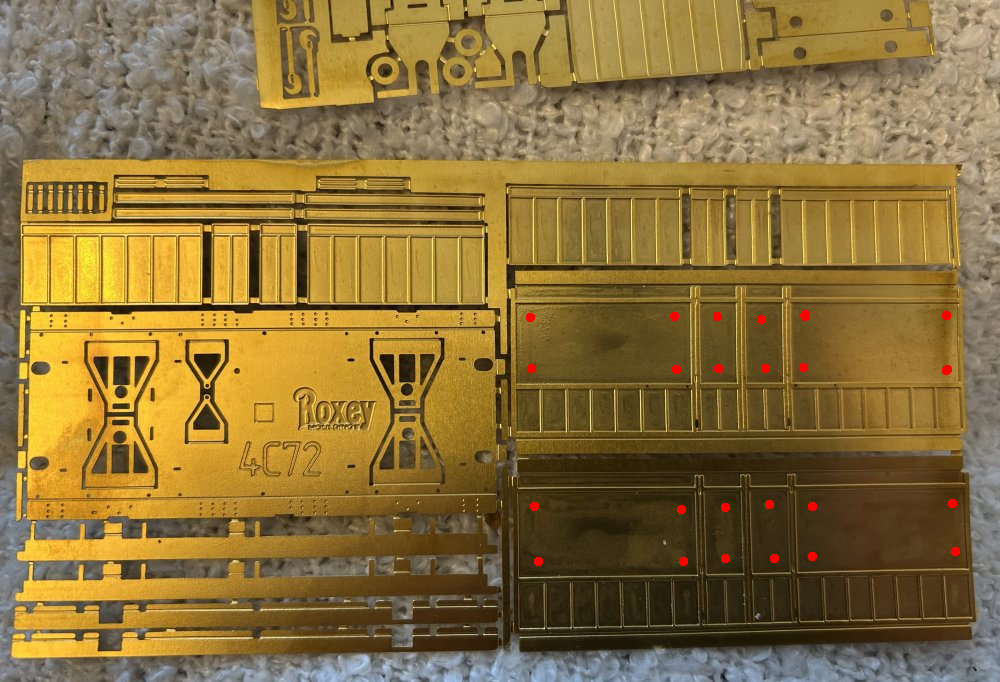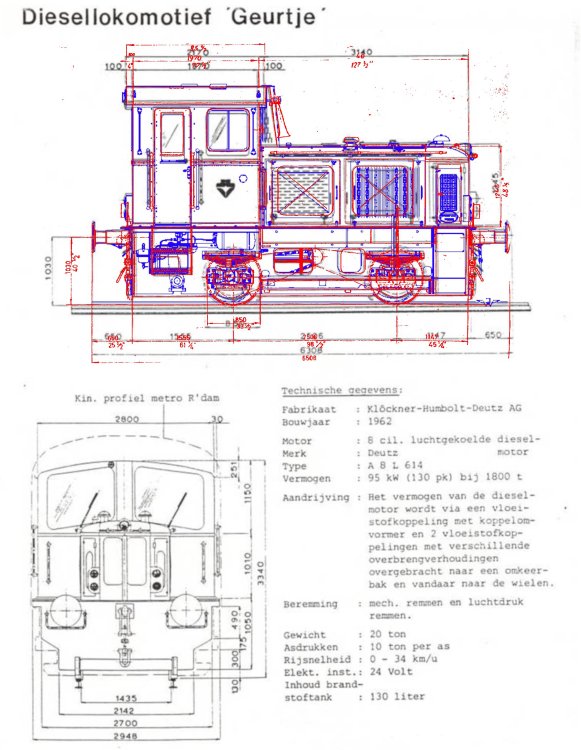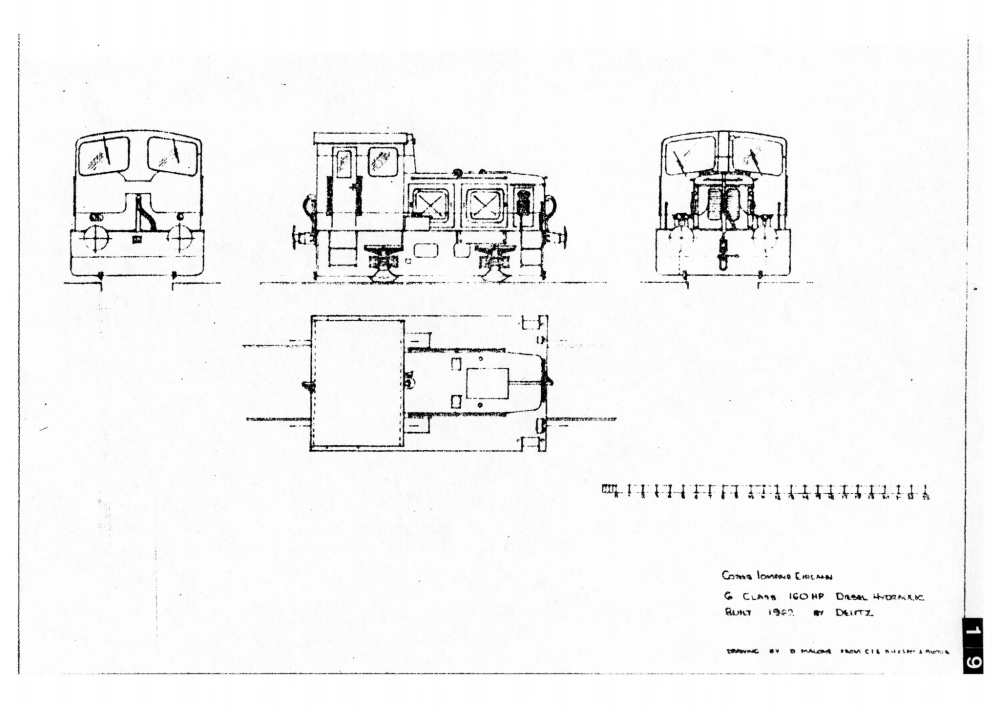
Mol_PMB
Members-
Posts
2,159 -
Joined
-
Last visited
-
Days Won
112
Content Type
Profiles
Forums
Events
Gallery
Blogs
Store
Community Map
Everything posted by Mol_PMB
-
Interesting - many thanks, I never knew that. Was this to enable a longer train beyond the capacity of the small generator in the driving car? Or was the driving car omitted entirely? What was the maximum speed for such a train? I recall the push-pulls had a lower speed limit perhaps owing to the different bogies on most of the driving cars?
-
https://www.flickr.com/photos/irishrailwayarchive/54419646114
-
Looks good. See what your mentor says, but if I were building it I would drill some holes roughly where I've put the red spots below, so that I could solder the overlay panels from the back.
-
With my pedantic head on... Suburban push-pull coaches didn't say Intercity on the side, well not in their earlier years at least. The unique buffet car 6402 had all sealed windows but could run in Mk3 push-pull sets, it was on the Waterford link for a while. I thought the three Mk3 EGVs were converted for the Enterprise rather than the regular suburban push-pulls.
-
Interesting, thanks for sharing. I think this just refers to downloading images, rather than viewing them. Users can block downloads of their images and IRRS has done this anyway, so I don't think this will affect IRRS images. Though my interpretation may be wrong. IRRS is a Pro member.
-
Further on the 'Silver Princess', and additional to the thread linked by Mogul, there is an article with drawings in N.I.L. 3.6 (November 2004) available here: https://newirishlines.org/archive/ There is a good broadside view of it in original condition in Harris's book on BR MK2 coaches. Also here in a photo from Robert Carroll's collection:
-
The title 'Waterford and Dublin Junction Railway' and the idea of a terminus on the peninsula made me think of the reversal at Kilkenny, with the Lavistown direct line.
-
trackplan [Answered] Can a 'double deck' layout be achieved?
Mol_PMB replied to Josef2000's question in Questions & Answers
A few things to consider: Gradients From lengths of stations on your plans it looks like you plan to run quite long trains. What's the steepest gradient your planned train formations will be able to climb? And what gradient will can the loco restart the train on? Curves also add extra resistance - what's the steepest gradient on a curve that the trains can manage? In general, steam loco models don't pull as well as modern diesel locos. You may also need to improve the free-running of some of your rolling stock. You could do some experiments on this with a plank and a few lengths of track. The last thing you want is to spend ages building a layout and then find your favourite trains are slipping to a stand or burning out motors. Once you've worked out a suitable gradient then you can look at other aspects of the design. For the purposes of the next stages I'm going to guess at a maximum 1:60 gradient on curves. Helixes On a helix the tracks are arranged vertically above each other. This means that there is a minimum vertical spacing between the tracks that has to account for your tallest rolling stock, plus the height of the track, the underlay, the board and any board supports, and a little bit of clearance. In 4mm scale this will total around 80mm. With the 1:60 gradient, that means that the track distance around the circumference of the helix must be 80 x 60 = 4800mm. Divide by pi (3.14) to get the diameter of the helix = approx 1500mm. That's the diameter of the (inner) track centreline and so the outer diameter of the helix will be a bit more, especially if it's double track - approx 1600mm. That would be quite big on your room plan, though not impossible, and it would wipe out a good amount of scenic space. Making the helix more compact requires increasing the gradient and making the curves sharper, both of which will limit the train length that can reliably climb them. Multiple Level Scenic Layout Here the levels have to be further apart than a helix - usually a lot further apart. Below the track you'll need thicker supports for the boards, and space for point motors, wiring etc. Above the track you'll need space for trains and scenery. But crucially you also need space to build and maintain these, so space to get your arms and head in, space for a power drill, screwdriver, hammer, static grass applicator, whatever. I'd say you would need around 500mm minimum between scenic levels, although this could be reduced if one or more of the levels is narrow (shelf-like) and can be accessed easily from the side. Think about how you will lay track accurately, install point motors etc in a confined space. And how you can replace/maintain those items once installed and with all the scenery around them. Whole-room-spiral layout Put the multiple levels on a gradient and you get a whole room spiral which I think is what @Horsetan is suggesting, and is also basically what I'm doing with my Swiss layout (which is end-to-end). It looks like the circuit of your room would be about 10000mm so for a 1:60 gradient you would achieve 10000/60 = 167mm spacing between levels. That's nowhere near enough for a scenic level. You could perhaps alternate scenic and non-scenic levels (i.e. just have plain track on a shelf against the back wall on the intermediate levels) which would double the run length and double the spacing between scenic levels. Of course you can steepen the gradient, if your trains can manage it reliably. Whole-room spirals are fundamentally end-to-end layouts because of the level difference between the two ends, unless you add a second, inverted spiral or helix to get the trains back down to where they started. That's starting to get really complex. I don't mean to discourage you, just to give you food for thought. A really important factor is to set your maximum gradient because the geometry of everything else is defined by that. -
trackplan [Answered] Can a 'double deck' layout be achieved?
Mol_PMB replied to Josef2000's question in Questions & Answers
I have a long-term project with a multi-level layout in my garage, in Swiss Om scale. There are challenges in achieving a satisfactory vertical spacing between levels - once you have considered the thickness of the board, support, point motors, scenery and space to view it etc then you need a good 400-500mm between scenic levels. Helixes have a large footprint regardless of gradient but become even bigger for more gentle gradients. It’s all possible but needs careful planning! -
Agreed, though I think that’s a significant factor in the retention of ancient 4-wheel trams in Lisbon. The modern trans formed of many small segments like a caterpillar might struggle with Lisbon’s combination of hills and sharp curves. Even the 4-wheelers become 3-wheelers on one of the summits! More puzzling to me: 1. It crosses the river east of the city island, presumably a new bridge but both banks in this area are actively used by shipping at present, as are some wharves a little upstream, and a bridge here would prevent that. There’s no room for the approaches to a tunnel under. 2. Where is the airport branch?
-
CIE had some of these smaller tanks to the RCH 1907 regulations too: https://www.flickr.com/photos/irishrailwayarchive/53510434252 There were also larger Class A tanks (silver, for less dense products with a lower flash point) and some of the newer ones (1930s onwards) were pretty similar to the Dapol 'Air Ministry' tanks recently released in both 7mm and 4mm scales. https://www.flickr.com/photos/irishrailwayarchive/54251527313/in/album-72157661623942928 There were also older Class A tanks to the 1907 specifications: https://www.flickr.com/photos/irishrailwayarchive/53511761675
-
There are some more photos and info on the Irish Shell wagons in N.I.L. 3.2 November 2002, available to read here: Archive | New Irish Lines edit: also see N.I.L. 2.6 November 2001 for more on Irish tank wagons and some further references.
-
I've seen reference to Irish Shell transfers available from SSM, but I can't see them on the website. Custom transfers are easy and cheap though. It would certainly be a possibility for IRM to partner with Oxford in the same way that they have done with Heljan; that may be easier now that Oxford is independent of Hornby. But I don't have a crystal ball as to whether that might occur. I quite fancy an older class B (black) tank wagon to provide fuel for the imaginary fishing boats on my imaginary Fenit layout.
-
Making an ‘E’ – the Maybach Diesel Model Assembly thread
Mol_PMB replied to Mol_PMB's topic in Irish Models
Attached are the completed set of instructions, and the list of photo links, which can be sorted/filtered by loco number, livery, date, view etc. E401 Build Instructions.pdf E401_Photolist.xlsx On the loco itself, I've removed it from its little travel case, and fitted the Kadee couplers (#58), which didn't come to Ireland because I was using their mounting holes to fasten the loco to the plinth. It's ready to start work - 'all' I need is a layout -
2600 class livery variants and more
Mol_PMB replied to Niles's topic in Photos & Videos of the Prototype
Ah, wonderful, thanks for the detailed info. So, where to next with the Tailte 2600s - Foynes? -
2600 class livery variants and more
Mol_PMB replied to Niles's topic in Photos & Videos of the Prototype
Are the unit formations fairly consistent or do they get swapped round regularly? There must have been some swaps at some stage in their life. I’m wondering whether there were any mixed-livery sets? Are there many still with the gangways? I did see one other set with them last weekend. -
I've tried scaling, aligning and overlaying the 3 drawings of the German/Dutch version. They're similar but not quite identical in shape. I also found this elsewhere on the forum, so now I need to try and overlay this too. It's not great quality though = does anyone know of a better version?
-
I was looking at tank wagons today. I've come to the conclusion that the Oxford Rail tank wagon (which has been recently re-released) is near-identical to the smaller-diameter Irish Shell tank wagons, one of which is preserved by the RPSI. Here's the prototype, this isn't actually the RPSI one but it's the same; these are to the 1907 RCH standard and the photo dates from 1964 so they had a good long life: Here's the model: Here's the preserved one: For OO gauge this would just need re-lettering on the tank. I wonder how hard it would be to widen the frames for 21mm, and hide the join in the middle?
- 15 replies
-
- 10
-

-
What a wonderful glasshouse on wheels! https://www.ebay.co.uk/itm/396385603443
-
I'll add a few to keep the ball rolling, focusing on some books that you might not expect to contain rolling stock drawings but have a few gems within. The book 'Wesk Cork Railways' by Chris Larkin has an unconventional scrapbook-like format but it is filled with evocative photos, reminiscences and facts. It contains stocklists of CBSCR locos, carriages and wagons, and a few drawings of CIE rolling stock that worked the line. These include: A good drawing of an AEC railcar including side, end and plan views with dimensions. Side and end elevations of CIE composite coach which I think represents the 2130-2136 series of 1952 - this is a painting diagrams showing the position of lettering and logos. Side elevation of an H van - again a painting diagram The Oakwood Press book 'The Farranfore to Valentia Harbour Railway', volume 2, by Patrick O'Sullivan, contains the following drawings: A good drawing of 20-ton Ballast Van 8457 including side, end and plan views, though not dimensioned (this was the red brake/tool van used on the lifting train) Dimensioned side and end elevations of the GSR cattle wagons built in 1944 Dimensioned side and end elevations of the CIE cattle wagons built 1947-1959 The Oakwood Press book 'Rails to Achill', by our very own Jonathan Beaumont, contains the following rolling stock drawings (there are also drawings of buildings etc): Side and end elevation of D16 4-4-0 'Achill bogie' with some dimensions Dimensioned side, end and plan views of MGWR 6-wheel 5-compartment third class coach Dimensioned side, end and plan views of MGWR 6-wheel 2-compartment brake third coach (with birdcage) Dimensioned side, end and plan views of MGWR 6-wheel full brake coach (with birdcage)
-
Old Goods Wagons with Center Roof Canvas?
Mol_PMB replied to Auto-Train Original's topic in Irish Models
The roof opening also allowed heavy items to be craned into them and then covered over. Similar vans were used on the big island too, but they lasted longer in service in Ireland. -
Where did you get the BTB gauge, and have you got any track gauges? I made my own BTB gauge and am considering making my own track gauge, but if they're available to buy from somewhere that would be easier.
-
Welcome to the club! I look forward to seeing what you create with them.
-
If there is sufficient space then the optimum would be to put loops both sides of the main line, and have the platforms on the loops. That way the expresses can overtake the locals while they are stopped at the station.
-
I think it would be easier in some places than others, particularly where there were once sidings alongside the main line. Extended loops would be more practical than 4-tracking throughout.
.png.c363cdf5c3fb7955cd92a55eb6dbbae0.png)





